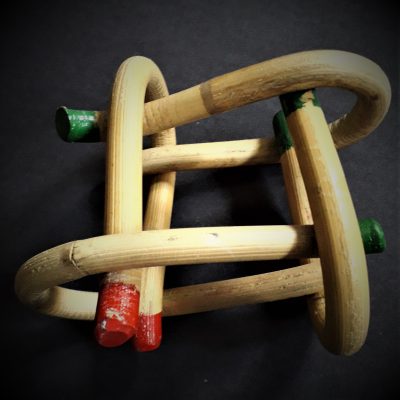Vipunen finger-exercise equipment
In 2006, six interior designers from the Points Group worked with the Institute of Design to develop tools that visually impaired people could make at home. The prototypes were presented at their shop. The Vipunen finger exercise device I had designed was shown for the first time and was also featured on MTV 3’s morning show.
- Vipunen finger-exercise equipment (Photo:Tapani Pelttari, Opte Oy)
- Photo: Ahti Taskinen
In her later years, my mother was worried that she was losing her grip. At the time I thought it was a phenomenon of ageing, but when I thought about the Arla Institute project, it came back to me. Could you get an instrument designed for that purpose? I searched the internet for available gadgets and found most of them to be instruments based on metallic spiral binding. The second option was based on ball squeezing. I could not see rattan anywhere.
The rattan felt warm in the hand and bent easily when dampened. I first made a U-shaped piece and nailed wooden balls to the ends to prevent the instrument from slipping out of the grip. It didn’t look good and had too many parts. I sketched and spun it around in my mind while squeezing the instrument in one hand to get a feel for it.
With a wooden model, the tools would always be the same shape, but making one piece would be slow and five hundred moulds would be needed to make one for each visually impaired entrepreneur. I considered the options and when I visited the Arla institute workshop, I saw how the teachers were using jigs to make rattan chairs and tables.
Dozens of 2-3-metre-long rattans just the right size for my needs was soaking in the pools. I was thinking of a jig where you drill holes in a sheet of plywood and glue pegs in them, so that one U-shaped instrument would be next to another. It would become a line of U-shapes and the rattan would be threaded between the pins like a snake. The rattan would then be cut into pieces and the outwardly curved ends would become retainers to prevent the instrument from slipping. The object was teaching me while I was designing it.
The object was squeezed and rebounded in my hands, but still provided sufficient resistance. Hands are different so you need tools of various sizes. This can be done by changing the size of the U and the diameter of the rattan.
The price was set at five euros, and Annansilmät-Aitta took the product to several fairs. Then its production was stopped due to a shortage of rattan. According to the explanation I heard, Asian countries were no longer willing to sell raw rattan, but only finished products.
With Vipunen I was perhaps the closest to a perfect product: Original, functional, durable, industrially manufacturable, simple, harmonious, affordable and can be sent in an envelope.
Vipunen must be tied so that it does not become loose over time, but if there are four products, you can put them on a ring, and they will bind one to the other. The product was short-lived but fulfilled the mission of the Arla Institute by providing visually impaired people with the opportunity to employ themselves.

